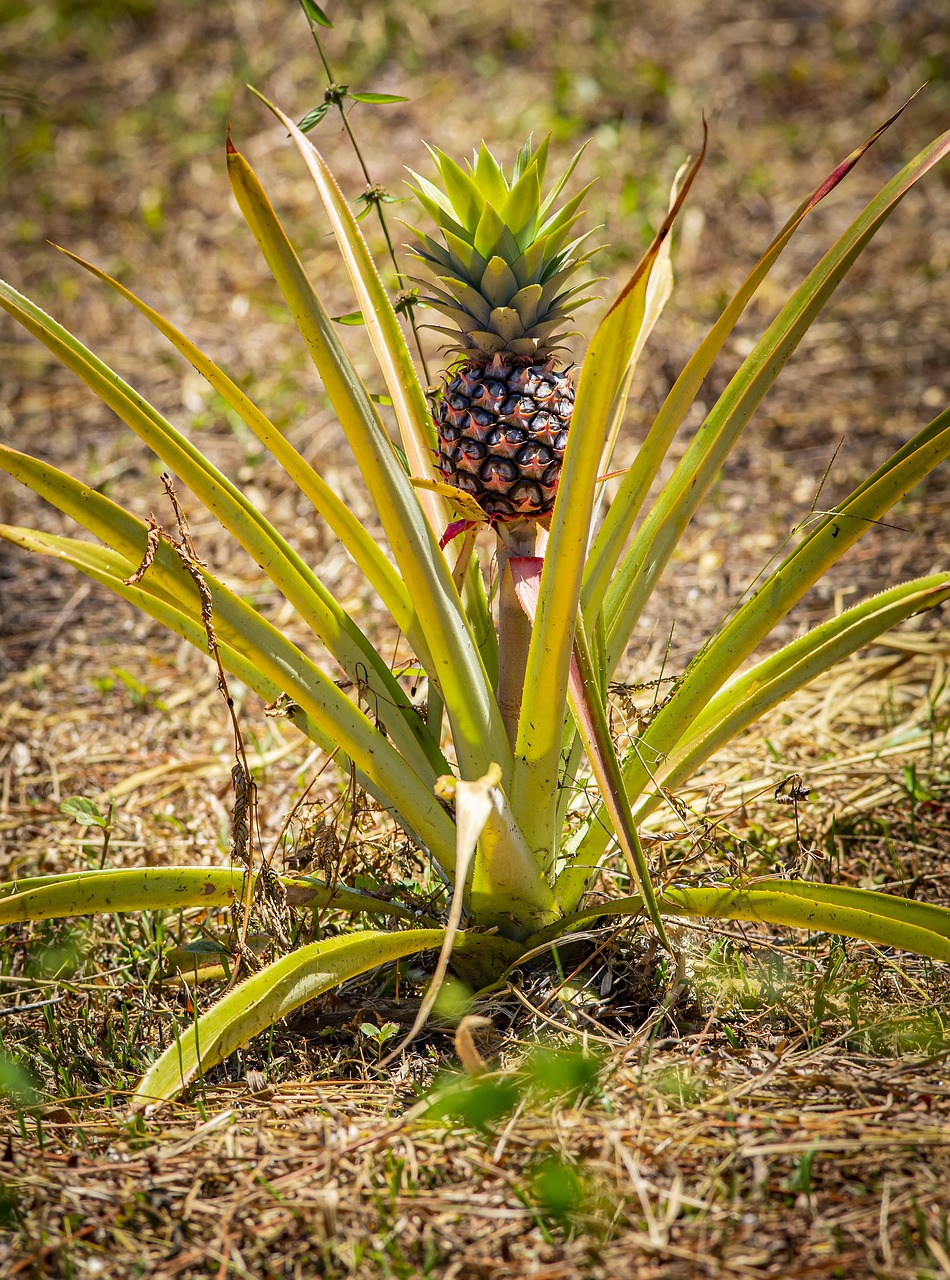The pineapple (Ananas comosus) is a tropical fruit that is loved for its sweet and tangy flavor. Native to South America, it is now cultivated in many tropical and subtropical regions worldwide, including Southeast Asia, Central America, and the Caribbean.
Characteristics:
- Appearance: A pineapple is a large, oval or cylindrical fruit with a tough, spiky outer rind. The rind is green when unripe, turning yellow, orange, or golden-brown as it ripens. It has a crown of stiff, spiny leaves on top.
- Flesh: The interior is juicy and yellow, with a fibrous texture. Pineapple flesh is sweet, slightly acidic, and aromatic.
- Size: The fruit typically ranges from 1 to 5 pounds (0.5 to 2.5 kg), though some varieties can be much larger.
Nutritional Benefits:
- Vitamins and Minerals: Pineapple is rich in vitamin C, manganese, vitamin B6, and dietary fiber.
- Enzyme Content: It contains bromelain, an enzyme that helps break down proteins and is believed to aid digestion and reduce inflammation.
Uses:
- Culinary: Pineapple is consumed fresh, juiced, or cooked in a wide variety of dishes, from desserts to savory meals. It is popular in salads, smoothies, tropical cocktails, and as a pizza topping.
- Preserved Forms: Pineapple can be canned, dried, or turned into jam or syrup.
- Traditional Medicine: In some cultures, pineapple and its juice have been used for their digestive and anti-inflammatory properties.
Growing Conditions:
- Climate: Pineapple plants thrive in tropical and subtropical climates with plenty of sunlight, moderate humidity, and well-drained soil.
- Propagation: Pineapples are grown from the crowns of the fruit or from suckers produced by the parent plant. It takes about 18 to 24 months for a pineapple plant to produce its first fruit.
Fun Facts:
- Pineapple is not a single fruit but a composite of many individual berries that have fused together around a central core.
- The pineapple became a symbol of hospitality in the Americas during the colonial era due to its exotic appearance and rarity.
ChatGPT said:
ChatGPT
Here’s more about the pineapple, diving into its cultivation, historical background, and some interesting uses in recipes:
Cultivation of Pineapple:
- Growing Conditions: Pineapples require a warm climate, preferably tropical or subtropical, with temperatures ranging between 68-86°F (20-30°C). They need full sunlight, good air circulation, and soil that drains well. Pineapples can tolerate periods of drought but do not thrive in waterlogged or extremely cold conditions.
- Planting: Pineapples are usually propagated from crowns (the leafy top of the fruit) or suckers (shoots that grow from the base of the plant). The crown is cut from the fruit, dried for a few days, and then planted. It takes about 6 to 12 months for the plant to become established, and another 12-18 months to produce a fruit.
- Harvesting: When the pineapple turns golden-yellow and smells fragrant, it is ready to be harvested. The timing varies by region and cultivar, but typically, pineapples are harvested once they reach full maturity.
Historical Background:
- Origin: The pineapple is believed to have originated in the region between southern Brazil and Paraguay. Native tribes in these regions cultivated the plant and spread it throughout South America and the Caribbean.
- European Introduction: Christopher Columbus is credited with introducing the pineapple to Europe in 1493 after encountering it on the island of Guadeloupe. Due to its rarity and difficulty to grow in non-tropical climates, the pineapple became a symbol of wealth and hospitality in Europe.
- Spread Globally: Pineapple cultivation spread globally in the 17th century, particularly to tropical colonies in Asia, Africa, and the Pacific islands. Today, countries like the Philippines, Thailand, Costa Rica, and Brazil are some of the largest producers.
Uses in Recipes:
- Sweet Dishes:
- Pineapple Upside-Down Cake: A classic dessert where pineapple slices are caramelized with butter and sugar, then topped with cake batter and baked. The cake is inverted to showcase the glossy, golden pineapples.
- Tropical Smoothie: Blended with coconut milk, banana, and a hint of lime, pineapple adds a fresh, tangy flavor to smoothies.
- Grilled Pineapple: Thick slices of pineapple can be grilled and served with a scoop of vanilla ice cream or drizzled with honey for a simple but delicious dessert.
- Savory Dishes:
- Hawaiian Pizza: A controversial but popular pizza topped with ham and pineapple, blending sweet and savory flavors.
- Pineapple Fried Rice: A Thai-inspired dish where rice is stir-fried with pineapple chunks, shrimp or chicken, cashews, and a mixture of spices for a sweet, tangy flavor.
- Pineapple Salsa: A refreshing condiment made with diced pineapple, red onion, cilantro, jalapeño, lime juice, and salt. It pairs well with grilled meats, fish, or tortilla chips.
- Beverages:
- Piña Colada: A famous cocktail made with pineapple juice, coconut cream, and rum, often garnished with a slice of fresh pineapple and a maraschino cherry.
- Pineapple Juice: Freshly squeezed pineapple juice is delicious on its own or can be mixed with other fruit juices and spices for a tropical punch.
Fun Facts:
- Symbol of Hospitality: In colonial America, displaying a pineapple was a way to welcome guests and show hospitality. Pineapples were often displayed in centerpieces or carved into furniture and architectural designs.
- Regrowth: After a pineapple is harvested, the plant can produce new fruit from suckers that grow from its base. This regrowth makes it a sustainable fruit for continuous production.
Visited 850 times, 15 visit(s) today
Views: 1278
Subscribe to the newsletter:
